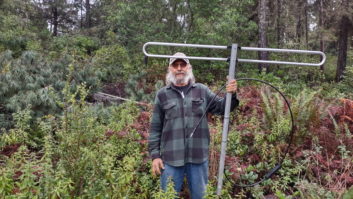RWEE received numerous comments on Ron Nott’s article “A Thoughtful Look at Lightning” in our April 15 issue. Nott suggested a practical alternative to lightning rods: Place large numbers of grounded, conductive sharp points on all earthbound tall structures at as high elevations as practical.
One reader commented, “If ‘the solution’ were true then lightning would never strike a pine forest.”
Nott responds:

I have already researched this as a result of a strike on a pine tree while a ham radio group was installing a mountaintop repeater in Colorado. It is true that there are thousands of needles projecting into the air, but there is not a low resistance ground path for the dissipation current. This is absolutely essential for charge dissipation to succeed. Lightning often occurs before the onset of rainfall, so the trees are dry and provide relatively high resistance. Ideally the ground path should be less than 5 ohms, but dry pine trees provide thousands of ohms of resistance. Early transmitters often used dry wood as insulators.
I was pondering on the hammer blow effect of a lightning strike. To fully understand it, one must be familiar with the coulomb, a definition from a scientist and mathematician of the 18th century. If you Google it, you will find several pages of math; but reduced to simplest terms, it is “one ampere for one second.” On the surface, this seems like very little. Someone even calculated the number of electrons in one coulomb (it may have been Professor Coulomb himself) and it is a massive number.
But what is important is the time frame in which a lightning strike occurs. If we look at the current from one coulomb in one microsecond, it is one megamp. A massive current for a short period of time. While few strikes occur in that timeframe, many occur in from 10 to 30 microseconds. In 10 microseconds, this is still 100,000 amps! The rise time is incredibly short (in nanoseconds) and this is the hammer blow that causes the damage. And a typical strike lowers from 10 to 30 or so coulombs, which multiplies the current by this factor. A really big strike may lower up to 200 coulombs, which can break concrete and do massive damage.
My point is that big power in megawatts is not required. It is the release of this energy in an extremely short period of time that does the damage. Bear in mind that I understand big power. I was employed at a 2,050 megawatt power plant for twelve and a half years. The two giant units generate 750+ megawatts each and the combined output of the HP and LP generators from one unit is ~25,000 amps per phase at 22,000 volts, considerably larger than any power used in broadcasting, but much smaller voltage than in a lightning strike.
Ron Nott is the founder of Nott Ltd., a communications equipment and service company.












